
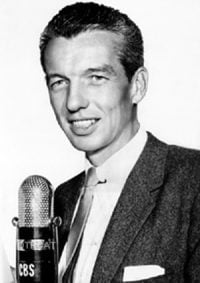 [Editor’s note: This week I am pleased to turn over hosting duties to Asimov’s author and Old Time Radio fan Pete Wood. Pete chose this episode and did the writeup for it. My only contributions are the pulp magazine covers at the bottom of the page and their writeup. Along with the fine episode Pete has chosen I think the two internal ads will be of interest to listeners as well, each for entirely different reasons.]
[Editor’s note: This week I am pleased to turn over hosting duties to Asimov’s author and Old Time Radio fan Pete Wood. Pete chose this episode and did the writeup for it. My only contributions are the pulp magazine covers at the bottom of the page and their writeup. Along with the fine episode Pete has chosen I think the two internal ads will be of interest to listeners as well, each for entirely different reasons.]
Yours Truly, Johnny Dollar (1949-1962) aired“The Ghost to Ghost Matter” on May 18, 1958. Johnny Dollar ran on CBS from February 18, 1949 until September 30, 1962. Three actors—Charles Russell, Edmond O’Brien, and John Lund—played Dollar as a not too original tough-talking private eye until the initial incarnation ended in September, 1954.
After a one year hiatus the show returned with a new star and a new format. Bob Bailey (1913-1983, photo top right) played Dollar as a freelance insurance investigator, and radio veteran Jack Johnstone took over production and directing duties, as well as writing many of the episodes.
Bob Bailey was Dollar until November 1960 when the network fired him when he refused to relocate from Hollywood to New York. Bob Readick then portrayed Dollar from December, 1960 until June 1961 with Mandel Kramer taking over the role until the last episode.
Bob Bailey was the heart and soul of the series. Of the 827 episodes, Bailey played Dollar for 484. Second place O’Brien, by contrast, only appeared in 103 episodes.
The show typically began with a phone call from some insurance executive who wanted Dollar to investigate some unusual claim. Dollar traveled all over the United States and sometimes out of the country. He told the story through flashbacks as he explained each item on his “action-packed expense account.”
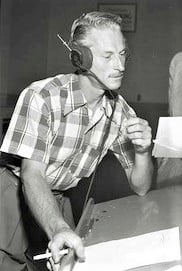 Johnny Dollar is not easily fooled. A straight shooter, he has a way of sniffing out deception. “The Ghost to Ghost Matter” (written by producer and director Johnstone, 1906-1991, photo at left) is a rare foray into the supernatural. An unsettling phone call awakens Dollar in the dead of night. An insurance company five years ago paid out the $55,000 in life benefits for Ian MacAndrews, the founder of Lake City, New Jersey. The local insurance man panics, because “Ian MacAndrews is haunting Lake City.” Johnny is, to say the least, skeptical.
Johnny Dollar is not easily fooled. A straight shooter, he has a way of sniffing out deception. “The Ghost to Ghost Matter” (written by producer and director Johnstone, 1906-1991, photo at left) is a rare foray into the supernatural. An unsettling phone call awakens Dollar in the dead of night. An insurance company five years ago paid out the $55,000 in life benefits for Ian MacAndrews, the founder of Lake City, New Jersey. The local insurance man panics, because “Ian MacAndrews is haunting Lake City.” Johnny is, to say the least, skeptical.
Johnny is anxious to get down there, but tells the insurance agent he’ll “have to think about it.” Johnny smells a rat and has “a strong suspicion that if you can catch a ghost off guard, you’ll be one up on him.”
Dollar calls up Nancy Turner, “an old flame,” who also happens to dabble in supernatural investigations. Nancy is quite intrigued and agrees to accompany him. Like an Eisenhower era Mulder and Scully, Johnny, the skeptic, and Nancy, the believer, head for New Jersey.
How they get there sheds some light on how things have changed in the past sixty years. They take a train from Hartford to Grand Central Station where Dollar rents a car. Personally I can think of no worse place to pick up a rental car than Manhattan.
The town fathers are surprised, yet very grateful, when Johnny shows up with a psychic investigator. They tell Johnny the ghost only appears at midnight and Johnny should relax until the witching hour. Lucky for Johnny, the city has a lake full of bass and the town is only too happy to give him a boat and equipment for the afternoon. Fishing is Johnny’s Achilles heel. He’d “rather fish than eat.” He seems to work in some fishing in many of the episodes somehow, and when he takes time off, he goes fishing.
While fishing is Dollar’s true obsession, girls, not so much. Johnny Dollar was married to his work and never really had a steady girlfriend. Not that the girls weren’t interested. Nancy is a little miffed when he calls after a long absence, but can’t hide her eagerness to see him again.
Not to give away anything, but the town fathers deliver a real honest to God haunted house, and much to his dismay Johnny can’t explain any of it.
Television surpassed radio in many areas, but radio, with its theater of the mind, always did horror and the supernatural better. The best special effects of the time, and even today, can’t compete with what our imaginations are capable of conjuring up. And, the descriptions of the haunted house give the listener pause. We can easily see why Dollar, a man of reason, begins to question what he is seeing.
Bob Bailey had a long radio career, beginning in the early thirties and ending with Johnny Dollar. He starred in programs too numerous to name, but his most successful role until Johnny Dollar was as private investigator George Valentine in Let George Do It from 1946 to 1954 on the Mutual Broadcasting System. Virginia Gregg, who portrayed Nancy Turner, played his secretary, Brooksie, for many episodes.
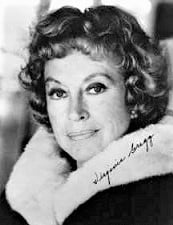 Virginia Gregg (1916-1986) had a long career in radio, television and films. She appeared on such radio programs as The Adventures of Sam Spade, Dragnet, Dr. Kildare, Gunsmoke, The Jack Benny Program, One Man’s Family, The Zero Hour and Mutual Radio Theater. She often did double duty with roles in both the radio and television versions of programs. Gregg once said of her work as a character actress on television: “I work steadily, but I have no identity.” She added, “When casting people have a call for a woman who looks like the wrath of God, I’m notified.” On television, Gregg appeared in programs such as Hawaiian Eye, 77 Sunset Strip, Gunsmoke, Bonanza, Perry Mason, The Rockford Files, Maverick, My Favorite Martian, and The Twilight Zone. Her forty five film roles included the voice of Mrs. Bates in Psycho, Psycho II, and Psycho III. Oh, yeah, and she also played double bass for the Pasadena Symphony.
Virginia Gregg (1916-1986) had a long career in radio, television and films. She appeared on such radio programs as The Adventures of Sam Spade, Dragnet, Dr. Kildare, Gunsmoke, The Jack Benny Program, One Man’s Family, The Zero Hour and Mutual Radio Theater. She often did double duty with roles in both the radio and television versions of programs. Gregg once said of her work as a character actress on television: “I work steadily, but I have no identity.” She added, “When casting people have a call for a woman who looks like the wrath of God, I’m notified.” On television, Gregg appeared in programs such as Hawaiian Eye, 77 Sunset Strip, Gunsmoke, Bonanza, Perry Mason, The Rockford Files, Maverick, My Favorite Martian, and The Twilight Zone. Her forty five film roles included the voice of Mrs. Bates in Psycho, Psycho II, and Psycho III. Oh, yeah, and she also played double bass for the Pasadena Symphony.
Gregg and Bailey are obviously enjoying their reunion in this lark of a story. It’s a fun episode and it’s neat seeing the man with all the answers struggle to explain what’s going on. So, turn out the lights and enjoy “The Ghost to Ghost Matter.”
Play Time: 24:31
{May of 1958 saw the neighborhood gang eagerly looking forward to summer vacation, their thoughts turning to the magazines they would buy at the corner newsstand after school. It looks like the editor of the May fantastic (1952-1980) was dreaming of summer as well when he commissioned the cover for the issue below. fantastic was a monthly in 1958. Fantastic Universe (1953-1960) didn’t last long, relatively speaking, but was a viable second tier outlet for colorful adventure fiction, whether straight up science fiction or science fantasy. It also was a monthly in 1958. The Original Science Fiction Stories (1955-1960) had a shorter run than even Fantastic Universe, and, like Fantastic Universe, provided a much needed outlet for genre fiction since many other early SF/F pulps had finally folded (Weird Tales folded in 1954, and Planet Stories, Startling Stories, and Thrilling Wonder Stories all folded in 1955). The Original Science Fiction Stories managed 8 issues in 1958. It is well to remember that while a number of the early, well-loved pulps had folded, a fair number of top-tier magazines arose to take their place: though Astounding (first issue 1930) was still very much a top shelf magazine, newcomers F&SF (first issue 1949). Galaxy (first issue 1950), and then IF (first issue 1952) gave Astounding–and lesser, struggling magazines like the ones below (and Amazing, whose glory days were far behind it)–stiff competition.]
[Left: fantastic, May 1958 – Center: Fantastic Universe, May 1958 – Right: Science Fiction Stories, May 1958]
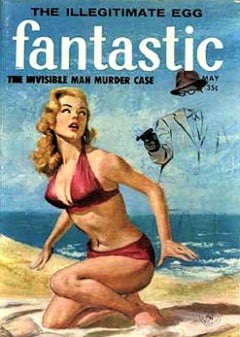

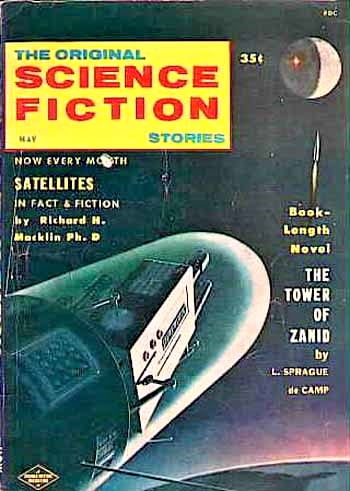
To view the entire list of Old Time Radio episodes go here.